A door knob that falls off can be a source of frustration and inconvenience, disrupting the smooth functioning of your home’s entryways and interiors.
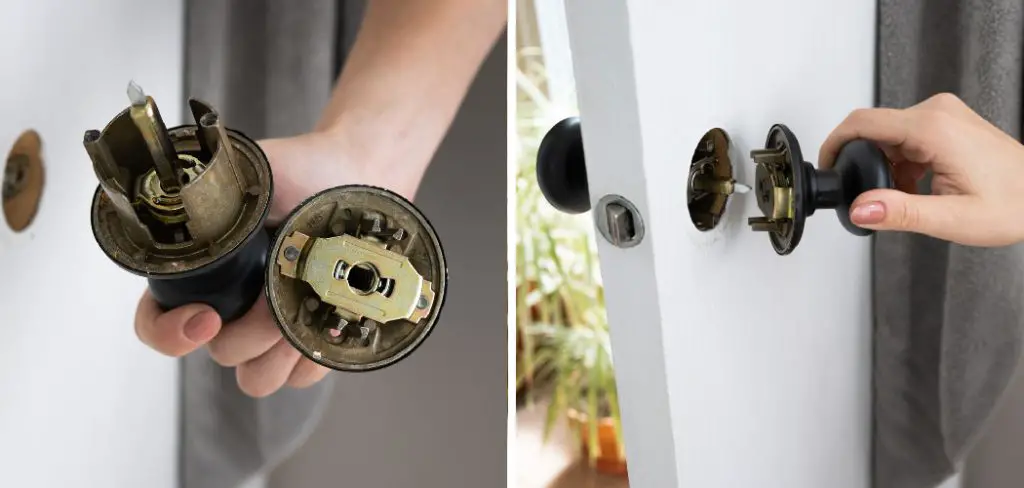
Whether it happens on a frequently used door or a seldom-accessed one, a fallen door knob requires prompt attention to restore proper operation and security.
This guide will provide you with comprehensive, step-by-step instructions on how to fix door knob that fell off.
We’ll cover the tools you’ll need, such as screwdrivers and possibly new screws or a replacement knob, and explain how to assess the cause of the problem, whether it’s loose screws, a broken spindle, or wear and tear over time.
By following these instructions, you can reattach the door knob securely and ensure it remains functional for the long term. With a bit of effort and the right approach, you can quickly resolve this common household issue, maintaining both the aesthetics and practicality of your doors.
The Inconvenience and Potential Security Issues
One of the primary concerns with a fallen door knob is not just the inconvenience but also the potential security issues it introduces.
A door without a functioning knob cannot secure properly, leaving your home vulnerable to unauthorized access. This is especially critical for exterior doors, where robust lock mechanisms are essential for keeping intruders at bay.
Even for interior doors, a missing or malfunctioning knob can pose privacy issues, whether it’s a bathroom door that needs to stay shut or a bedroom door that you want to keep closed. Addressing a loose or fallen door knob promptly is crucial to restore both the functionality and security of your home.
Promptly Addressing the Problem
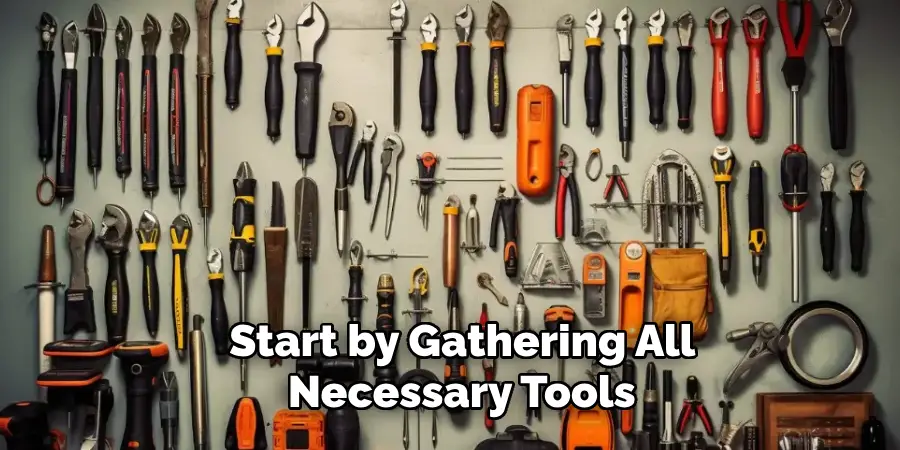
To promptly address a fallen door knob, start by gathering all necessary tools and materials.
You’ll typically need a screwdriver that matches the screws on your door knob, replacement screws if the old ones are damaged, and potentially a new spindle or door knob set if the existing components are beyond repair.
First, inspect the door knob and the door to identify the problem: check for loose screws, a broken spindle, or any wear and tear.
Tighten any loose screws, ensuring they are securely fastened, and replace any damaged or missing parts. If the spindle is broken, it will need to be replaced to ensure the knob can turn properly and engage the locking mechanism.
After reinstalling or replacing parts, test the door knob to confirm it’s functioning correctly. By addressing the issue promptly, you can prevent further damage and maintain the security and usability of your door.
This approach not only resolves the immediate problem but also extends the lifespan of your door knob and enhances the overall safety of your home.
Assessing the Situation
Before diving into the repairs, it’s crucial to properly assess the situation to understand what went wrong with your door knob. Start by examining the door knob itself for any visible signs of damage or wear. Check if the screws that hold the knob in place are loose or missing.
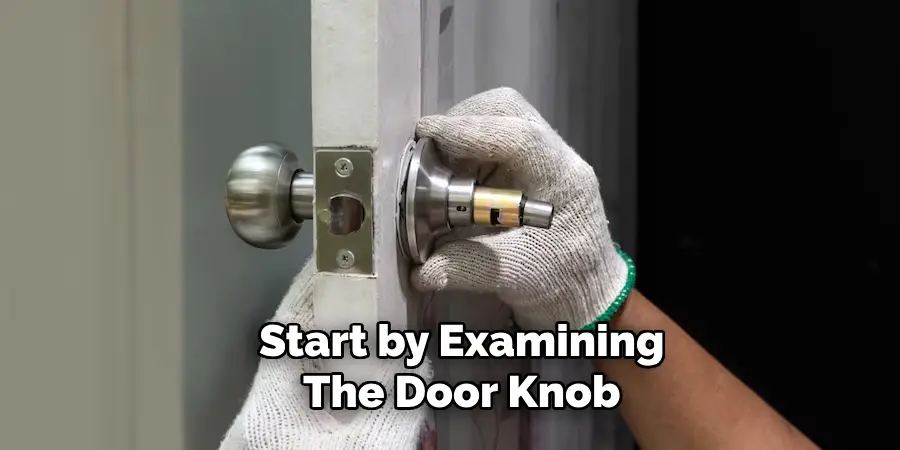
Observe the spindle, the metal rod that connects the two halves of the knob through the door, for any signs of breakage or distortion. Additionally, inspect the latch mechanism within the door to ensure it is not stuck or damaged.
By identifying the specific issues affecting the door knob, you can determine whether you need to simply tighten screws, replace broken components, or purchase a new door knob entirely. This thorough assessment will guide you in selecting the appropriate tools and materials, ensuring a successful and efficient repair.
Gathering Tools and Materials
Before starting the repair process, it’s essential to gather all the required tools and materials to ensure a smooth and efficient repair. Here is a list of items you will likely need:
- Screwdrivers: Both flathead and Phillips screwdrivers, depending on the type of screws used in your door knob.
- Replacement Screws: In case the existing screws are worn out or damaged.
- Allen Wrench (Hex Key): Some door knobs require an Allen wrench to tighten or remove set screws.
- Replacement Spindle: If the spindle is broken or excessively worn.
- New Door Knob Set: Consider having a replacement door knob set on hand if the current one can’t be repaired.
- Lubricant: Such as WD-40, to ease the movement of the door knob and latch mechanism.
- Cloth or Paper Towels: For cleaning the door knob and surrounding area, removing dirt and debris.
- Small Container: To keep screws and small parts organized and prevent them from getting lost.
Gathering these tools and materials beforehand ensures that you won’t need to interrupt the repair process to find an additional item, making the entire task more efficient and less frustrating. Having everything prepared means you can focus on fixing the door knob without unnecessary delays.
10 Methods How to Fix Door Knob that Fell off
Method 1: Reattaching with Existing Screws
Often, a door knob falls off because the screws holding it in place have become loose or detached. To fix this, start by locating the screws that came loose. Align the door knob on the spindle, which is the rod connecting the door knob to the latch mechanism.
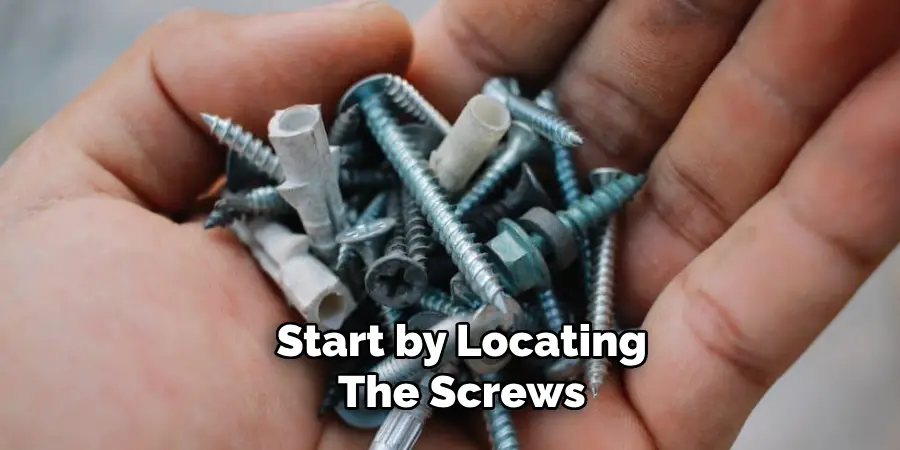
Insert the screws through the holes in the door knob and into the corresponding holes in the door. Use a screwdriver to tighten them securely. If the screws are stripped or worn out, consider replacing them with new ones of the same size to ensure a tight fit.
Method 2: Using Threadlocker
If the screws on your door knob frequently come loose, using a threadlocker can help. Threadlocker is a liquid adhesive that prevents screws from loosening due to vibration or frequent use. Apply a small amount of threadlocker to the threads of the screws before reattaching the door knob.
Insert and tighten the screws as usual. The threadlocker will harden and hold the screws in place, preventing them from backing out over time. This method is particularly effective for high-traffic doors.
Threadlocker is available in different strengths, such as low, medium, and high. Low-strength threadlocker is recommended for most door knob screws. This type of threadlocker allows for easy removal of the screws if needed in the future.
Medium-strength threadlocker is a good option for larger or heavier door knobs, while high-strength threadlocker should only be used for heavy-duty applications.
Method 3: Replacing the Spindle
Sometimes, the spindle connecting the two door knobs can be the culprit. If the spindle is worn out or broken, the door knob will not stay in place. To replace the spindle, remove the door knob and the latch mechanism.
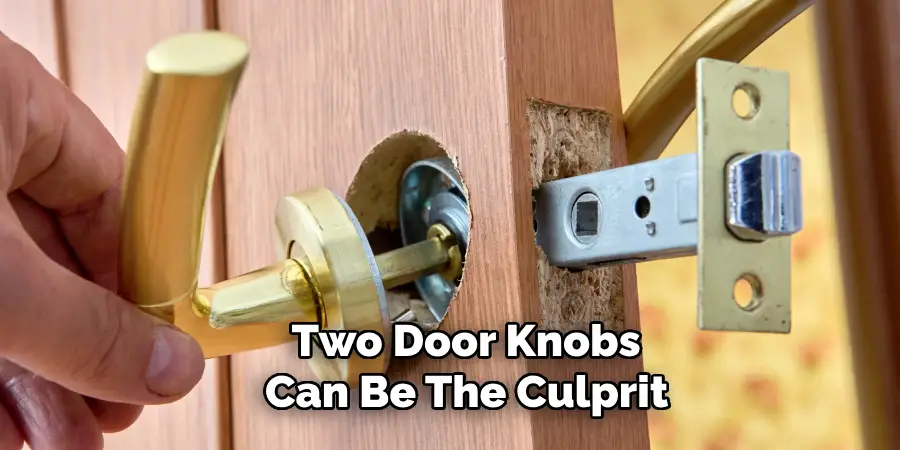
Measure the length and diameter of the existing spindle and purchase a replacement that matches these dimensions.
Insert the new spindle into the latch mechanism, align the door knobs, and secure them with screws. Ensure that the new spindle fits snugly and that the door knobs turn smoothly.
Method 4: Reinforcing with Wood Glue
If the screw holes in the door are stripped or enlarged, wood glue can be used to reinforce them. Remove the door knob and screws.
Apply wood glue to wooden toothpicks or dowels and insert them into the stripped screw holes. Allow the glue to dry completely, then trim any excess wood sticking out from the door.
Re-drill pilot holes into the reinforced area and reattach the door knob using the original screws. This method provides a solid base for the screws to grip, ensuring the door knob stays securely in place.
It is important to use wood glue specifically designed for furniture and woodworking projects, as it has a strong bond and can withstand the weight and pressure of a door knob. Additionally, make sure to properly clean and dry the surface before applying the wood glue, as any dirt or moisture can compromise the strength of the bond.
Method 5: Using Longer Screws
In some cases, the existing screws may not be long enough to secure the door knob properly. Replacing them with longer screws can provide a more secure attachment.
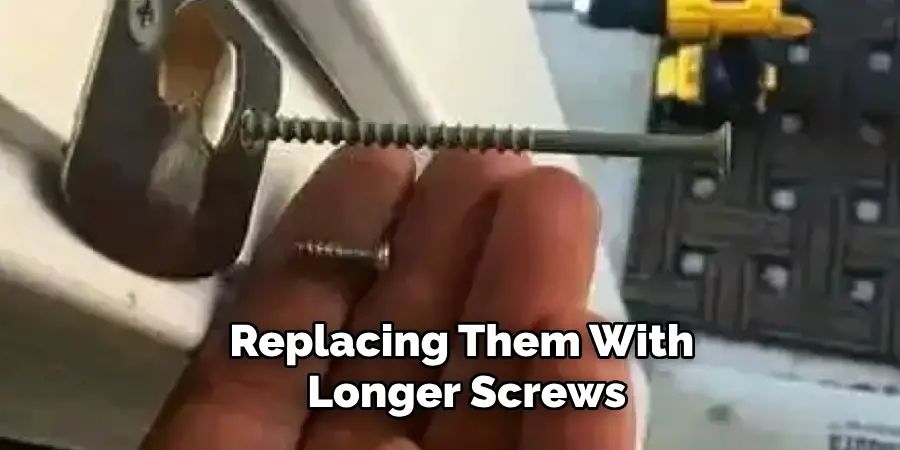
Remove the door knob and measure the length of the existing screws. Purchase screws that are at least an inch longer but have the same diameter and thread type.
Insert the longer screws through the door knob holes and into the door, tightening them securely. The additional length allows the screws to reach deeper into the door, providing a more stable hold.
Method 6: Installing a New Door Knob Set
If the door knob is old or damaged, replacing it with a new door knob set may be the best solution.
Purchase a door knob set that matches the style and finish of your existing hardware. Remove the old door knob, latch, and strike plate. Install the new latch mechanism in the door edge, insert the spindle through the latch, and attach the new door knobs on either side of the door.
Secure the knobs with the included screws and install the new strike plate on the door frame. Follow the manufacturer’s instructions for proper installation to ensure the door knob operates smoothly.
Method 7: Adjusting the Door Knob Backplate
The backplate, or escutcheon, is the decorative plate behind the door knob that also helps to secure it in place. If the backplate is loose or misaligned, it can cause the door knob to fall off. To fix this, remove the door knob and check the backplate for any loose screws or damage.
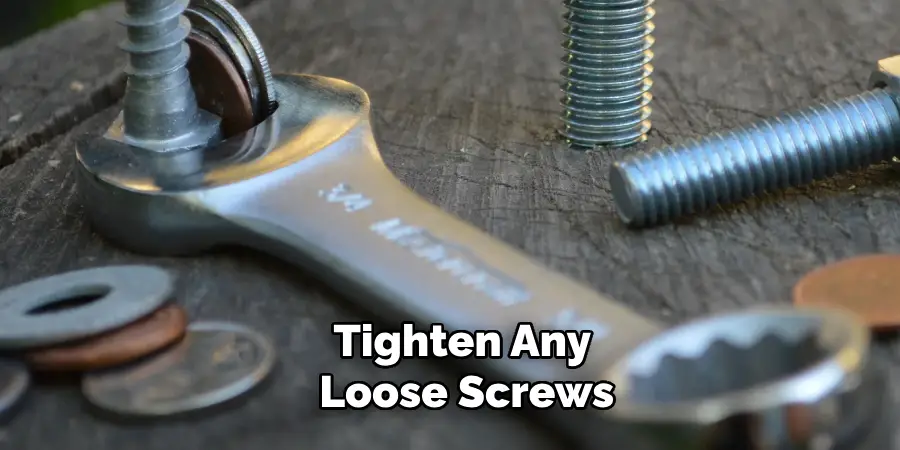
Tighten any loose screws and ensure the backplate is flush against the door surface. If the backplate is damaged, consider replacing it with a new one. Reattach the door knob and ensure it is properly aligned with the backplate for a secure fit.
Method 8: Using a Door Knob Repair Kit
Door knob repair kits are available for various types of door knobs and can be an effective solution for fixing a loose or fallen door knob. These kits typically include replacement parts such as screws, spindles, and backplates.
Follow the instructions provided in the kit to replace any worn or damaged components of the door knob assembly. This method ensures you have all the necessary parts to fix the door knob effectively and restore its functionality.
Method 9: Tightening the Set Screw
Some door knobs have a set screw on the side that secures the knob to the spindle. If this set screw becomes loose, the door knob can fall off.
To fix this, locate the set screw hole on the side of the door knob. Insert the door knob onto the spindle and use an Allen wrench or screwdriver to tighten the set screw.
Ensure the screw is tightened firmly but not overly tight to avoid stripping the threads. This method provides a secure attachment and prevents the door knob from slipping off the spindle.
Method 10: Seeking Professional Help
If you have tried the above methods and the door knob continues to fall off, it may be time to seek professional help.
A locksmith or carpenter has the expertise and tools to diagnose and repair more complex issues with door hardware. Professionals can identify problems such as internal damage to the door structure, worn-out components, or issues with the door knob mechanism.
While this method may involve a cost, it ensures a thorough and lasting repair, restoring the functionality and security of the door knob.
Things to Consider When Fixing a Loose Door Knob
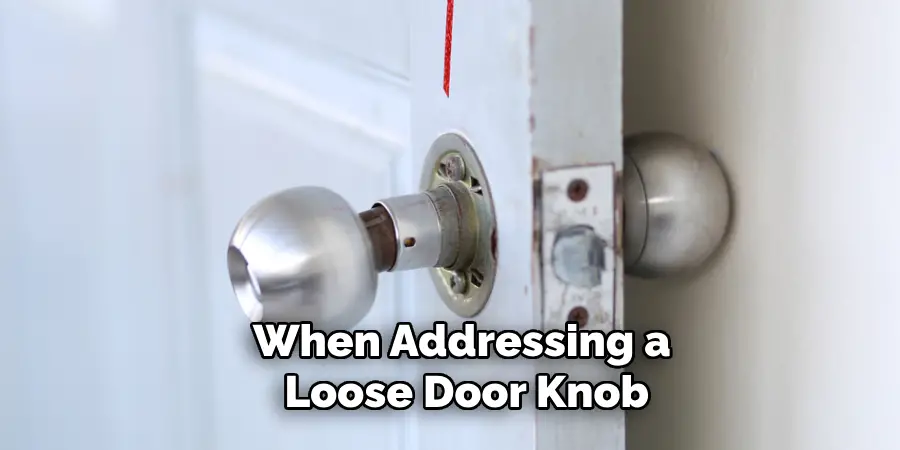
When addressing a loose door knob, it’s crucial to consider several factors to ensure a lasting and effective repair. First, assess the condition of the door and the knob itself. Older doors and hardware may require more careful handling or complete replacement.
Additionally, always use the appropriate tools and follow the manufacturer’s instructions to avoid causing further damage. It’s also wise to verify the compatibility of replacement parts such as spindles, screws, and backplates to ensure a proper fit.
Finally, consider the frequency of use and the weight that the door knob will handle, as these factors may influence the durability and stability of the fix. By taking these considerations into account, you can achieve a more reliable and lasting solution for your loose door knob.
Common Mistakes to Avoid
When fixing a loose or fallen door knob, there are several common mistakes that can lead to further issues or ineffective repairs. One frequent mistake is using the wrong size of screws or spindles, which can result in a poor fit and cause the knob to become loose again. Always ensure that replacement parts match the specifications of your door knob.
Another common error is over-tightening screws, which can strip the threads or damage the door’s material, making future repairs more difficult. Additionally, neglecting to reinforce stripped screw holes or failing to use the appropriate adhesive can result in temporary fixes that won’t hold up over time.
It’s also important to make sure the door knob alignment with its backplate and latch mechanism is correct; misalignment can inhibit proper operation and lead to premature wear.
Finally, ignoring manufacturer instructions and taking shortcuts can compromise the effectiveness of the repair. By avoiding these mistakes, you can ensure a more durable and functional door knob repair.
Safety Precautions for Fixing a Loose Door Knob
When fixing a loose door knob, taking safety precautions is essential to prevent injury and ensure the repair is done correctly. First, gather all necessary tools and materials before starting the task to avoid unnecessary interruptions.
Always wear protective gloves to shield your hands from sharp edges and potential splinters. Use safety goggles if drilling or hammering is involved to protect your eyes from debris. Ensure the door is stabilized and won’t move unexpectedly while you work; consider using a door stopper to keep it in place.
If using lubricants or adhesives, work in a well-ventilated area to avoid inhaling fumes. Keep small parts like screws and spindles out of the reach of children and pets to prevent choking hazards.
Finally, if you’re unsure about any step in the repair process, consult the manufacturer’s instructions or seek professional help to avoid causing further damage. By following these safety precautions, you can achieve a secure and effective door knob repair while minimizing risks.
Conclusion
Fixing a door knob that has fallen off involves a variety of methods, each tailored to address specific causes of the problem.
From tightening existing screws and using threadlocker to replacing the spindle and reinforcing screw holes, these methods offer comprehensive solutions to ensure your door knob remains securely attached. Regular maintenance and timely repairs can prevent issues from escalating, enhancing both the security and convenience of your door.
By following these detailed methods, you can effectively fix a loose door knob and ensure it operates smoothly for years to come. Hopefully, this article gave you some helpful tips about how to fix door knob that fell off successfully, so now that you have the proper knowledge on how to get the job done, why not give it a try today?
